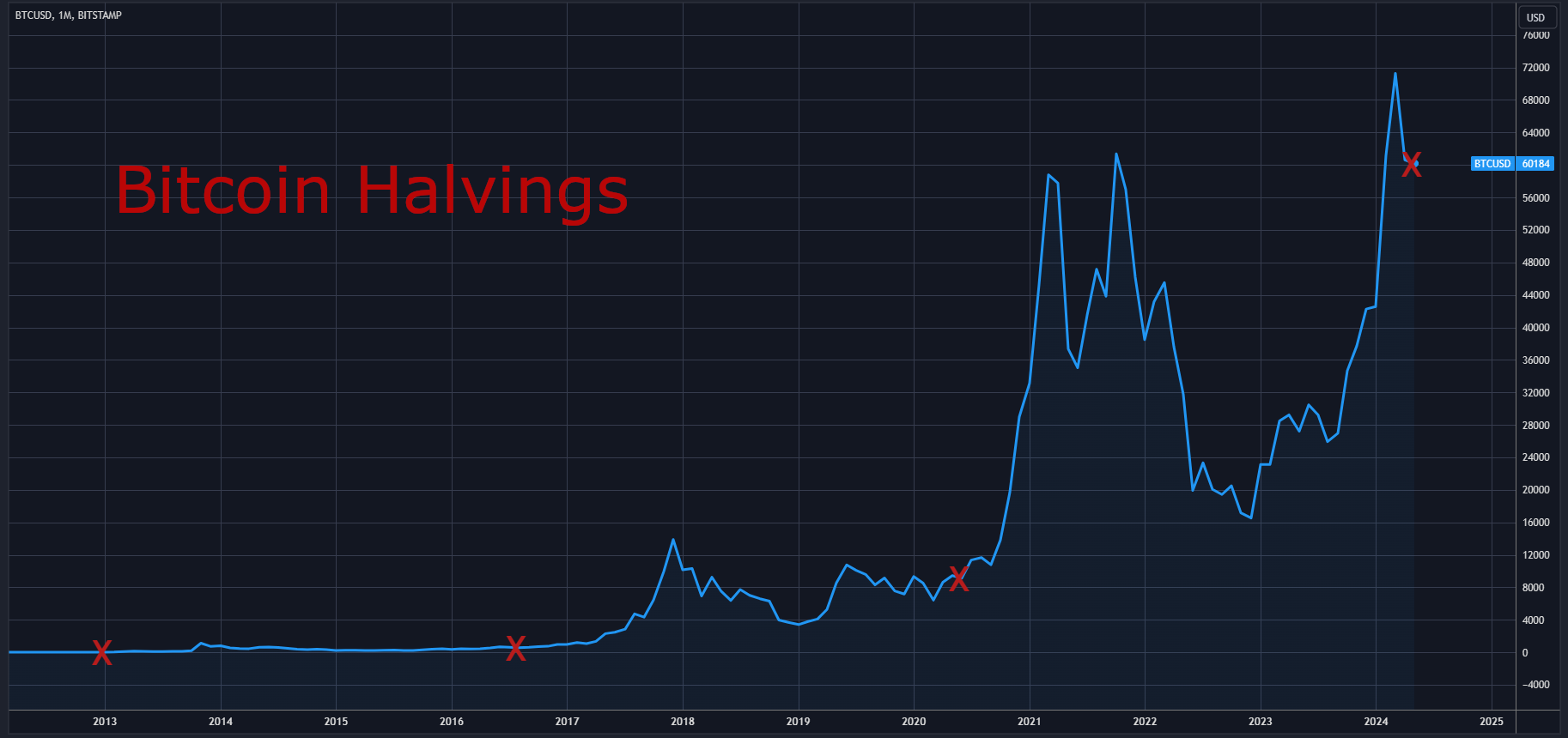

Bitcoin Halving:
May Not Have Intended Effect
Block Chop...
Bitcoin’s creator focused almost exclusively on scarcity as related to value, and programmed events called halvings to reduce the number of new bitcoins that can be created from mining. Halvings occur around every 4 years, and shrink the number of bitcoins created from mining by half. The latest halving happened last month on April 19, when the mining reward was cut from 6.25 to 3.125 bitcoins. Crypto proponents suggest halvings are correlated with bitcoin prices, causing them to rise. However, because the events happen just once every four years, it only provides a small sample size. Also, there have been just four halvings so far, which is a small number of observations to use when calculating correlation over eleven years.
Diminishing Effect
Bitcoin supporters claim that the increased element of scarcity introduced by the halvings support the value of bitcoin. However, though halvings limit the growth of new bitcoin creation, they do not reduce the number of bitcoins. The number of bitcoins still increases, just at a slower rate. Additionally, the vast majority of all bitcoins that will ever exist have already been created. Around 94% of the 21 million total bitcoins that will be mined have already been generated. Though it will take until 2140, there are just around 1.3 million bitcoin left to be mined out of the 21 million limit. Any price movements resulting from quantity might have been expected to be more pronounced while the number of bitcoins was lower, with prices being influenced less as quantity increases. Also, the effect the halvings have on the amount of new bitcoins created becomes less and less with each halving. Therefore, if the halving events did have an effect on bitcoin prices, the effect may be expected to diminish with each consecutive event.
Inefficient
The concept of market efficiency is a way of describing price movements as being influenced by all available information, with markets only reacting to new information. This means information that is already available will already be figured into valuations. For example, if a company announces it will take a certain action on a certain date, investors will account for the effects of that action before it actually happens. The expectations of investors will be reflected in the market price before the event takes place. The actual occurrence of the event may have little or no effect on the company stock price. Since the effect and timing of all halvings are predetermined, and their occurrence is not new information, bitcoin market participants should have already accounted for any effect the event would have on its value. Efficient markets only react to new information, as what is already known has already been priced in by investors. If the actual occurrence of a halving has an effect on bitcoin prices, it could indicate the market is inefficient.

Not Having It…
Though halvings were followed by price increases, they did not happen at the same time as halvings. The price increases that followed the halvings were also followed by steep price drops, which may not support the idea that halvings are a major influence on bitcoin prices. While bitcoin and the halving protocol are rooted in the concept of scarcity, scarcity alone does not result in value. A review of the precious metals and currency markets demonstrates that scarcity is not the sole factor in creating value. Bitcoin was intended as a replica of gold, mimicking its scarce nature and its need to be excavated through the labor-intensive mining process. Ironically, bitcoin is not gold-like in value, and has a low correlation to gold prices. Since bitcoin’s creator did not view it as being similar to stocks of companies, it may also be ironic that it has more of a relation to the movements of stock prices than to gold. Bitcoin has had a positive correlation to the stock market for most of its existence, and is now often considered as a risk asset, alongside stocks.
May 1, 2024
Resources:
Bitcoin forum posts can be viewed at this link.
Price and correlation data from TradingView.
More on bitcoin:
Bitcoin ETFs: Advancement or Setback for Crypto?
Cryo Crypto: Frozen Funds, Bankruptcy & Conflict
Crypto Markets: Low Regulation High Risk
Crypto Quantity: Satoshi’s Focus on Scarcity
Bitcoin & Inflation: Missing Links in Satoshi’s Vision
Bitcoin Beginnings: Satoshi’s Self-Fulfilling Prophecy
Bitcoin Correlations: Crypto Tethered to Stocks
Washed Out: Phony Crypto Volume
Markets Demystified is published on the first Wednesday of each month, and explores how stock market investing can relate to personal finance.
Thanks for reading!
Aesop Advisor LLC advertisements including newsletters and other publications are for informational purposes only. They do not attempt to predict future stock market moves and are not intended as individual investment advice. Aesop Advisor LLC newsletters and publications are not recommendations to buy, sell or hold any asset and are not intended as actionable investment advice or market timing. Equities references generally refer to the overall stock market, though if individual companies are mentioned, it is not a recommendation to buy, sell, or hold shares of the company. Unless otherwise indicated, terms including "stocks", the "stock market", and "market(s)" refer to Standard & Poor's 500 index. All investments involve risk and the past performance of a security or financial product does not guarantee future results or returns. While diversification may help spread risk, it does not assure a profit or protect against loss. There is always the potential of losing money when you invest in securities or other financial products. Publications and advertisements from Aesop Advisor LLC are not intended as investment, legal, or tax advice. Although gathered from sources believed to be reliable, Aesop Advisor LLC cannot guarantee the accuracy and completeness of data or information presented in publications and advertisements. This is an advertisement.